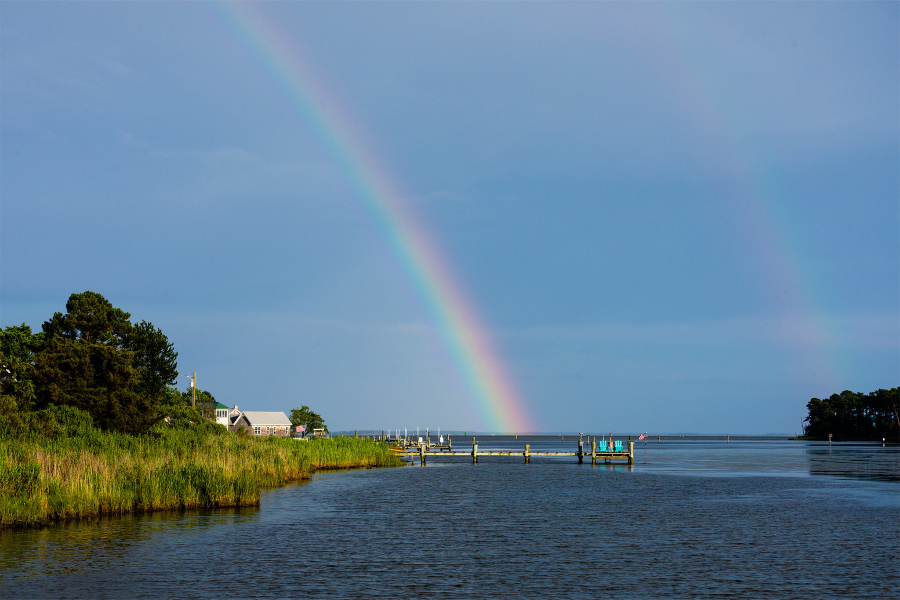Slight improvements in Bay health and new economic data added in 2021 Chesapeake Bay Report Card
The Chesapeake Bay’s overall score is up 5% from last year, receiving a C grade

On June 6, 2022, the annual report card measuring the health of the Chesapeake Bay and its watershed was released from the University of Maryland Center for Environmental Science (UMCES). It reported an overall slight positive trend in Bay health and incorporated new economic indicators for the full Chesapeake watershed.
At the press conference to unveil the report card, held at the Institute of Marine and Environmental Technology in Baltimore, Maryland, U.S. Representative Dutch Ruppersberger (D-Md.) spoke about the importance of allocating funding for restoration efforts and protecting this resource for Maryland and the rest of the jurisdictions in the watershed.
“A clean Chesapeake Bay is good for business,” Ruppersberger said. “Now it will take time to see the fruits of our efforts … but I’m confident this investment will pay off.”
The report card is split into two parts: the Chesapeake Bay and the full Chesapeake Bay watershed. The Chesapeake Bay’s report card focuses on water quality, with seven different ecological indicators. The watershed-wide report card includes an ecological category as well as a social category and economic category, which was first introduced this year.
This year, the Bay received a 50% which scores a ‘C.’ This is a 5% increase from last year's grade. Dissolved oxygen, total phosphorus, total nitrogen and underwater grasses have been designated “significantly improving,” based on long-term trends that go back to 1986.
However, in the short-term from 2020 to 2021, scores for dissolved oxygen and total phosphorus decreased, from 87% to 86% and 64% to 58%, respectively. Chlorophyll-a (a measure of algae growth) and water clarity (a measure of how much light can penetrate a water column) were both found to be “significantly declining.”
The Lower Bay was the highest scoring region at 65% while the Patapsco, Back and Patuxent rivers scored the lowest at 23%. Wastewater treatment facility issues have been cited in the Patapsco and Back rivers as contributing to poor water quality. However, recent investments made to upgrade infrastructure at the Back River Wastewater Treatment Plant is expected to improve water quality and the overall grade for the region, according to Horacio Tablada, secretary of the Maryland Department of the Environment.
“We are committed to restoring compliance,” Tablada said. “The infrastructure is there. It takes dedication [and] commitment … and this is something that’s a high priority for me.”

The watershed received a 56% or ‘C’ grade for 2021 and an economic category was added to the existing ecological and societal categories for the watershed grade. The watershed report card has existed since 2019 to better assess the health of the Bay. The watershed is the 64,000-square-miles of land surrounding the Bay, which is home to over 18 million people spanning six states and the District of Columbia.
The new economic section scored 51% and included four categories: median household income, housing affordability, income equality and net job growth.
Bill Dennison, vice-president for science applications at UMCES, said the new economic categories of income inequality and housing affordability address environmental justice, which relates to how environmental issues disproportionally impact lower-income communities.
“[The new economic indicators] combined with our societal indicators… provide a much broader view of the community that we want to embrace to be a part of this Chesapeake restoration,” Dennison said. “We need this restoration to be for all people regardless of race or income or social status, so these environmental justice indicators go a long way toward doing that.”
The ecological category included grades for protected lands, water quality and stream benthic community. Water quality received a score of 64%, which combined total phosphorus, total nitrogen and turbidity, and protected lands and stream benthic community (measure of the condition of organisms living at the bottom of the Bay) used 2020 scores of 74% and 51% respectively, since no new data was available for 2021.
The societal category scored a 60% and used some data from 2020 since no new data was available for the Social Index and Stewardship Index. The Social Index uses data about social vulnerability from the U.S. Census and measures how a community can respond to and recover from events such as natural disasters. The Chesapeake Bay Program’s Stewardship Index looks at categories of behavior, volunteerism and civic engagement. New data was available for the Heat Vulnerability Index which remained the same at 58% and the Walkability Index (how many neighborhoods have a park within a 10-minute walk) improved 5% from 62% to 67%.
The broader look at the watershed intends to address socio-economic disparities in the region to take into account social justice issues and diversity, equity and inclusion.
Dennison said looking at trends and creating more inclusive reporting methods is one big step towards improving the report card to represent all the complex environmental issues in the region.
“Part of this annual report is to try to improve our reporting,” Dennison said. “And ask ourselves what can we do better to get these report cards to resonate with every resident in this watershed, not just the privileged few that live on the Bay but the entirety of the watershed.”
View the full report card here. Stay up-to-date with the health of Bay on a regular basis by visiting ChesapeakeProgress.

Comments
There are no comments.
Thank you!
Your comment has been received. Before it can be published, the comment will be reviewed by our team to ensure it adheres with our rules of engagement.
Back to recent stories